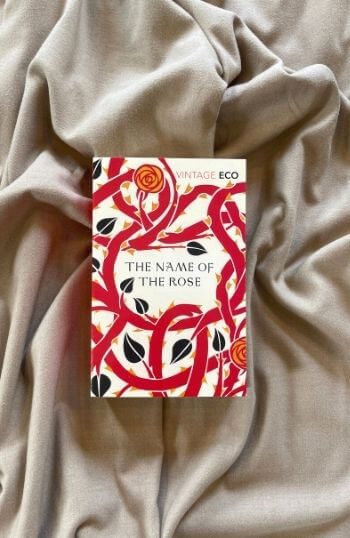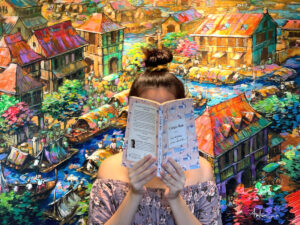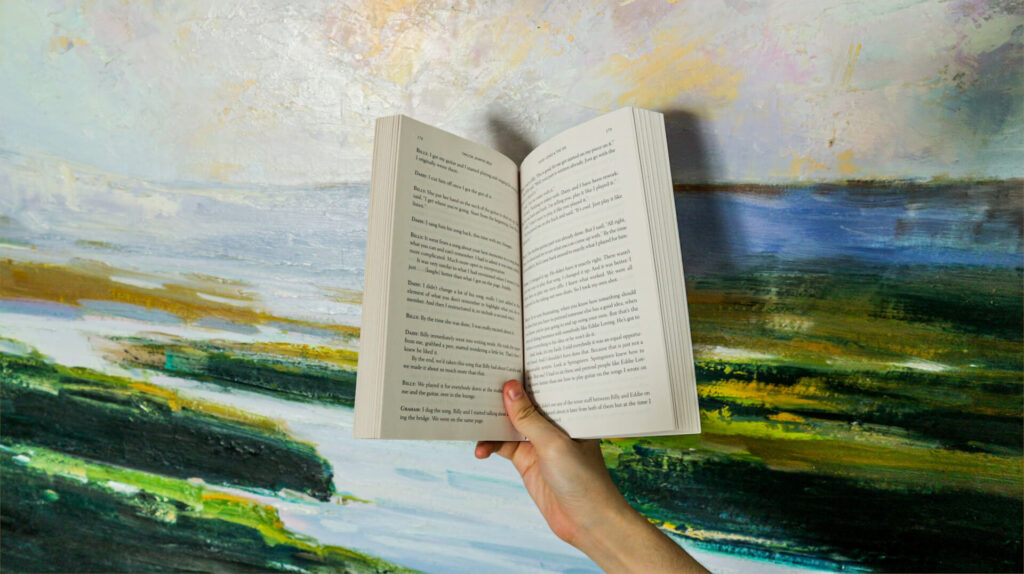Is having one single correct interpretation of a text possible? Can there be multiple truths to a single truth? Umberto Eco’s The Name of the Rose has some nuanced answers to these questions.
The dialogue I’m about to show you between Adso, a young monk, and William, his mentor, I think captures the essence of the novel’s answer to these questions the best.
This exchange happens around midway through the novel. Right before this bit, Adso was becoming increasingly confused on whose perspective was the correct one–the Pope’s argument that Christ didn’t live in poverty or the Franciscans’ argument that Christ did in fact live in poverty.
DIALOGUE EXCERPT
First, we have to talk about the genre of the book. Or rather, genres. Because while The Name of the Rose is a historical fiction, a classic, a philosophical even political novel; it’s also a mystery crime detective novel, something that resembles Sherlock Holmes.
In the novel, you have William and Adso investigating the killer or killers behind the murders at the abbey. And if we really think about it, detectives only have one goal in mind–and that is to know the truth. Who did what where and when, and how and why? So it’s so brilliant that The Name of the Rose pre-occupies itself with questions about truth.
CLOSE READING
Now, there are two different kinds of truth, both represented here in this excerpt. This debate between Adso and William is not just a debate between the two people, but also a conversation between two ideas. It’s a debate between the two different notions of truth that we have—between truth being this singular and incontestable thing versus truth being something that’s open to interpretation. Adso insists on the former, while William insists on the latter.
This notion of a singular truth, which is to say truth as an objective fact, is embodied by Adso.
You can almost hear the desperation in Adso’s voice to know the truth. He “cried” and insisted on getting answers from William twice in a row. This emotional outburst represents our “insane passion for the truth” (p. 527), a concept that I’ll be returning to later on.
For now, it’s clear that Adso is frustrated that he couldn’t figure out the singular truth. And it’s a singular truth he’s looking for because he used a singular article, “a position,” and a singular linking verb, “where the truth is.” The article “the” also communicates a forceful tone and emphasizes that there could only be one truth, the truth.
So the next line is William’s response that the truth may actually be a lot more complicated than that.
First, this line sets up William’s disposition and indicates to readers where his perspective is coming from. The lens suggest that William is a man of science, because reading glasses back in the 14th century were a cutting edge technology and is a testament to scientific progress.
The light is a symbol for clarity and intelligence, when people come up with bright ideas, they usually say they had a “lightbulb” moment. Even the phrase “bright” idea also alludes to light. So, these images of a pair of glasses and light paint a picture that William is a man of reason.
Then he asks Adso, “Look, what do you see?” The words “look” and “see” refer to our sense of sight. This emphasis on sensory experience suggests that William focuses on empirical evidence—that to support arguments or argue against them, one must have tangible evidence.
This view is so radically different from the other monks in the novel, who relied mostly on faith to argue for and against ideas. So different, in fact, that some of the monks have accused William of having been led astray by the Devil. By emphasizing this sense of sight to prove his point, William encourages Adso to also look at concrete evidence and to be rational.


Then, William shatters Adso’s belief that truth is this singular, objective fact by saying that the most we can do is look more closely.
Adso, of course, immediately refutes this.
And to his credit, Adso does have a point. No matter what you do, there are going to be hard, objective facts. It’s true, for example, that this The Name of the Rose analysis is on my blog. And the tool in the scene is a tool. And we know these to be true because we can measure them and we can see them. They’re pretty concrete.
But this is not the kind of truth that William is concerned with. William is more concerned with the higher truth, a truth based on constructs and abstracts.
In these lines, William acknowledges that the manuscript he’s attempting to read is a manuscript. By doing so, he acknowledges that there is such a thing as truth as an objective fact. But the meaning of the manuscript—the reading of the manuscript to find out what it means—that’s the kind of truth that cannot be measured. It’s abstract. Because meaning is naturally open to interpretation, then it’s difficult or, as the novel suggests, impossible to have a single and irrefutable kind of truth.
In fact, William says later on that “when we consider a book, we mustn’t ask ourselves what it says but what it means” (p. 338). “What the book says” refers to the words written on the page, which is something concrete and measurable. But William implies that the value of a text is not based on its words, but on the meaning we derive from these words. Words are pretty much useless if we don’t interpret what they mean.
The trouble, however, is that meaning is never singular because it’s open to interpretation, but a lot of the characters in The Name of the Rose still insist on one singular correct interpretation of a text, like the Bible, which is where much of the conflict in the novel stems from.
So if we go back to Adso and William’s dialogue, the tension here is somewhat rooted in a misunderstanding. Adso talks about truth as objective fact, while William talks about higher truth. In a sense, they’re both right because both kinds of truth do exist. But William wants Adso to recognize the existence of a higher truth–the one that requires interpretation—and how this higher truth is difficult or even impossible to know—but is very important.
Eco himself also seems to share this point of view:
DIFFERENT TRUTHS
The LitCharts analysis on The Name of the Rose articulates William’s point of view well:
In other words, the truth can come in many different forms, as many are its interpreters. The book argues against Adso’s point of view that there can only be one interpretation of a thing.
In fact, let’s also talk about the medium in which The Name of the Rose is told, which is the novel. Eco wrote in the postscript, “A narrator should not provide interpretations of his work; otherwise he would not have written a novel, which is a machine for generating interpretations” (p. 541). Eco leaves it all up to the reader to make interpretations of our own.
So when we ask, “what does this book, The Name of the Rose, truly mean?” We can’t really settle on one correct interpretation. The Name of the Rose encourages readers to generate interpretations of their own and by doing so, embraces the idea that truth comes in many different forms. The Name of the Rose actually practices what it preaches, and William would’ve been very happy.
RESISTANCE TO THE TRUTH
But characters in the novel resist William’s point of view, of the view that truth can come in many different forms. They still insist on one singular and incontestable truth.
We already know that Adso is frustrated with William’s idea.
This comes later in the novel, but even here Adso still insists on “the truth,” which is to say one single truth. And Bernard Gui is a character that bends the truth, whatever it is, to fit his agenda, disregarding other kinds of truths that may undermine his arguments.
And this phrase, “thirst for truth,” again has that same sense of a passionate kind of desperation to know a singular truth, similar to Adso’s tone in the main passage I analyzed earlier.
William knows the dangerous consequences of holding onto one single notion of truth, however. He tells Adso,
Contrary to popular opinion, William doesn’t see “dying for the truth” as something that’s necessarily honorable, but something insidious. Sure, “dying for the truth” can be a powerful symbol, but it also has real consequences that more often than not, affect the weak and the vulnerable, or in the words of the novel, “the simple.”
This “insane passion for the truth,” is something that The Name of the Rose argues we must free ourselves from. William reflects,
I think this line hits the nail on the head in suggesting that we must let go of the notion that truth is a singular thing. That in fact, there are countless forms of truth because people hold countless different beliefs and perceptions.
This is why Jorge, for example, an old blind monk who treats the words of the Bible as well, Bible, argued so vehemently against the idea of Jesus ever laughing and of laughter itself. Because laughter invites us to not take things too seriously, including the truth. And when we don’t take the truth too seriously, we become more open and more tolerant and more accepting of other people’s truths, not just our own.
CONCLUSION: LIFE TIPS FROM THE NAME OF THE ROSE
So, what does this discussion on truth mean? What does it mean when we say there’s no such thing as a singular correct interpretation of a text, a singular correct meaning of a sign, or a singular definition of “true success,” “true happiness,” “true love,” or any of the other things we can’t measure?
I personally think that this view encourages us to be more flexible and inclusive in our definition of what’s true. So many characters in The Name of the Rose either faced fatal consequences or severely punished others because they believed that only their version of the truth is true. They couldn’t accommodate anyone else’s.
Their intolerance to embrace many truths led to seriously horrific outcomes. I wish I could enumerate the evidence I have for this but I would be spoiling the book if I did so. But if you already read the book, then you’ll probably know the characters I’m alluding to.
Anyway, this doesn’t mean that we can just attribute meanings to things at random. This idea that truth has so many interpretations doesn’t give us license to make interpretations without any kind of support. We can’t just say things like “the Holocaust was a triumph for humanity.”
On the contrary, The Name of the Rose argues that because the truth takes on many different forms, it’s all the more important that we back them up with evidence, just like what the book’s man of reason, William, did as he investigated the murders at the abbey.
What are your thoughts on The Name of the Rose? Let me know in the comments! I also wrote a book review on this title in my April reading wrap-up.
If you found this article helpful, I have another close reading analysis on Things Fall Apart. Because The Name of the Rose deals with Christianity, you might also be interested to read about my personal views on religion.
JOIN THE WEEKLY NEWSLETTER!

Get updates on the latest posts and more from Alyanna Denise straight to your inbox. Guaranteed no spams.
By subscribing, you consent to receiving emails.
Thanks so much for reading!
— Alyanna
SOURCES & FURTHER READING
The Name of the Rose Study Guide (LitCharts)
Umberto Eco Interview: I Was Always Narrating (Louisiana Channel)


